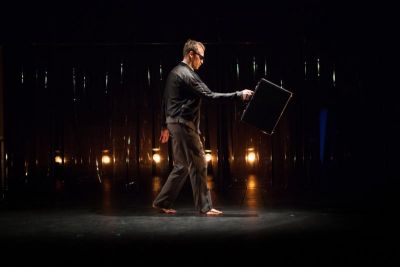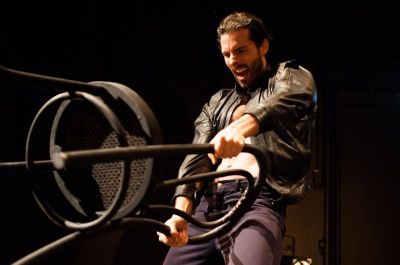Polygraph
Three characters connected by chance to a murder – in a play in which the murder itself is a McGuffin, a device to question the subjective nature of truth and all the forces that distort our sense of it.
Francois (Lachlan Woods), a waiter, was a prime suspect in a murder. He underwent a polygraph – or lie detector – test. He failed. The test was administered by David (Grant Cartwright), an émigré from East Germany. David withheld the test results from Francois, who, years later, doubts that which he believed to be true.
Francois’ neighbour is Lucie (Emily Thomas), who has an affair with the ambiguous David, but she is also an actress who auditions for a role in a movie, which happens to be about the murder, and in which she plays the victim… That is, she pretends to be the victim. That is, in a sense, she ‘lies’ that she is the victim – in order to create something that the audience will believe is true. But then Lucie is good at lying; she enjoys it. It’s a tribute to Ms Thomas’ shape-shifting performance that, as things proceed, we begin to wonder if Lucie is lying all the time.

Watching this layered, complex production, I doubt that anyone objects to the coincidence/contrivance. It could happen, and it throws up revelation after revelation - even if these only serve to deepen the mystery. What is truth? Or Truth? And can it be measured by the polygraph or any other means?
One of Robert Lepage’s ideas about art is that limits spur creativity. Here, director Tanya Gerstle has placed – or had placed – limits upon herself and her actors. Choice or force majeure? Lepage and Brassard’s 1988 play (later a 1995 movie, Le Confessionelle) is characteristic Lepage: ‘multi-media’, an admixture of performance and technology.
Ms Gerstle eschews the technology and relies on her three excellent cast, four bentwood chairs and wooden bench. Rather than a wall running right across the stage, specified by Lepage – and a key image and metaphor – designers Jelle Jager and Betty Auhl have scaffolding and a curtain of translucent plastic strips through which the characters can pass in both directions: a different metaphor perhaps, but completely in keeping with the play’s themes. Jason Crick’s lighting is subtle, utilising something almost like movie dissolves to indicate the passage of time, or different time frames – and Matt Furlani and Julian Dibley-Hall create grabs of sound – traffic, the babble of voices off, musical stabs – that enhance the tension.
 Ms Gerstle is highly skilled, inspired, in the creation of images that resonate, that evoke emotions. Her images here, aided hugely by the impressive physicality of her actors, convey as much meaning as the dialogue (much of which in this case, true to the French-Canadian origins, is in French). When we see David, in terror, escape from East Berlin over The Wall it is gripping – but so is Francois’ masochistic sexual encounter with an anonymous stranger – and Lucie playing the murder victim – or Francois binding and blindfolding her. Francois, the waiter, does things with those chairs that could be meaningless but in fact convey the depths of his angry despair and isolation. But do we feel for any of these characters? Perhaps not. The technique, the puzzle (but not a puzzle for a puzzle’s sake) keep us at a distance. What do we feel as we watch Lucie pretending very, very well to be murdered? Fascination. She’s pretending – but so well that we can’t fail to think of the ‘real’ murder…
Ms Gerstle is highly skilled, inspired, in the creation of images that resonate, that evoke emotions. Her images here, aided hugely by the impressive physicality of her actors, convey as much meaning as the dialogue (much of which in this case, true to the French-Canadian origins, is in French). When we see David, in terror, escape from East Berlin over The Wall it is gripping – but so is Francois’ masochistic sexual encounter with an anonymous stranger – and Lucie playing the murder victim – or Francois binding and blindfolding her. Francois, the waiter, does things with those chairs that could be meaningless but in fact convey the depths of his angry despair and isolation. But do we feel for any of these characters? Perhaps not. The technique, the puzzle (but not a puzzle for a puzzle’s sake) keep us at a distance. What do we feel as we watch Lucie pretending very, very well to be murdered? Fascination. She’s pretending – but so well that we can’t fail to think of the ‘real’ murder…
We could almost say that Polygraph is a kind of theatrical montage in which around twenty sequences juxtapose and strike meanings off the juxtapositions as in the classic Eisenstein formula: a + b = c. And does it all add up neatly at the end? How could it? This is a highly original, idiosyncratic production that would reward repeat viewings, but see it at least once.
Michael Brindley
Photos: Pier Carthew
Subscribe to our E-Newsletter, buy our latest print edition or find a Performing Arts book at Book Nook.

